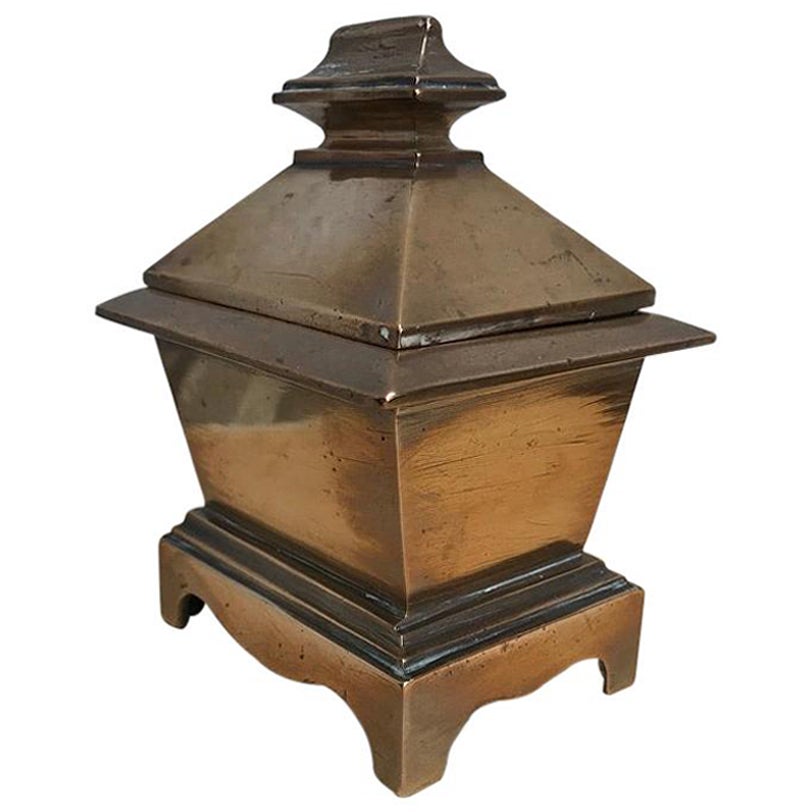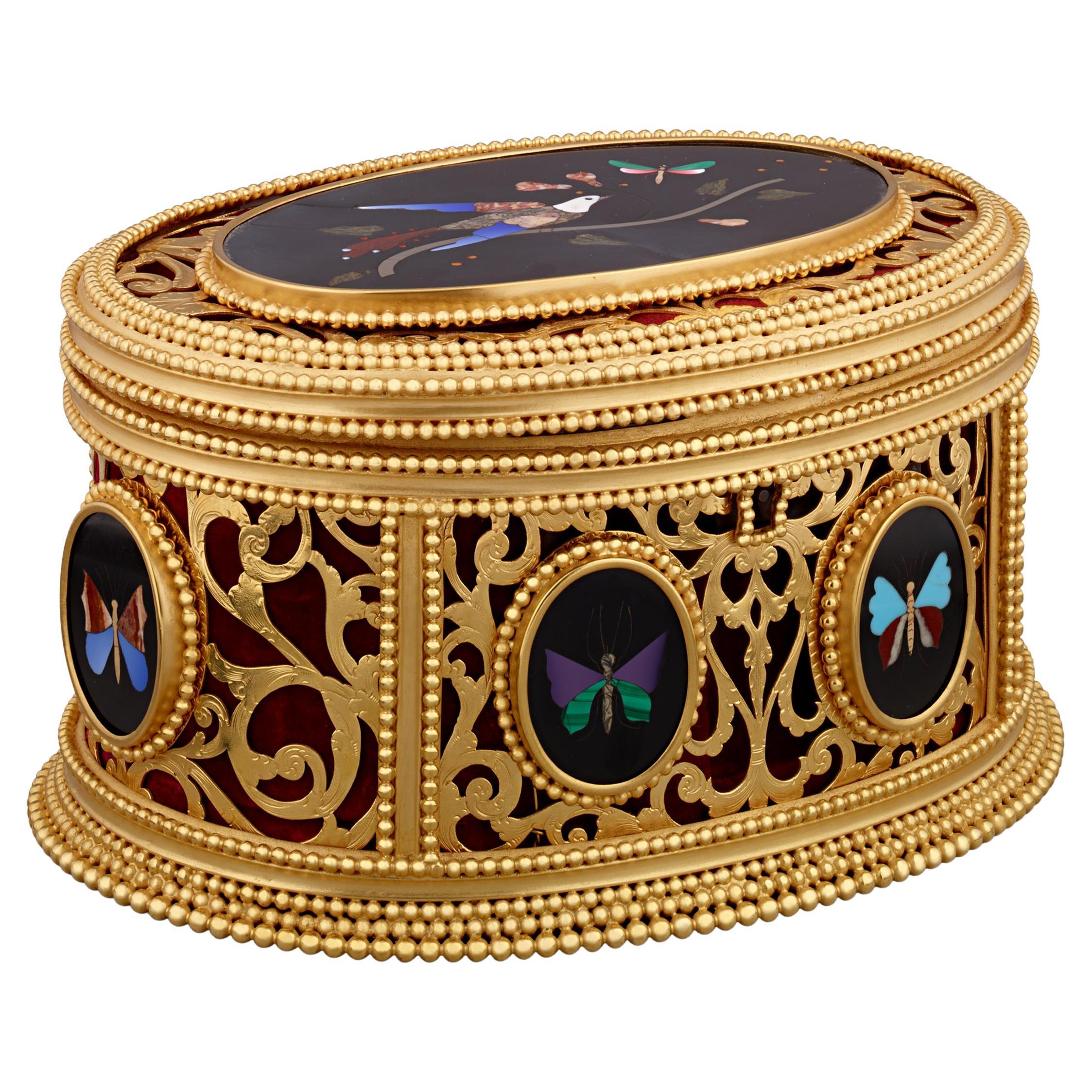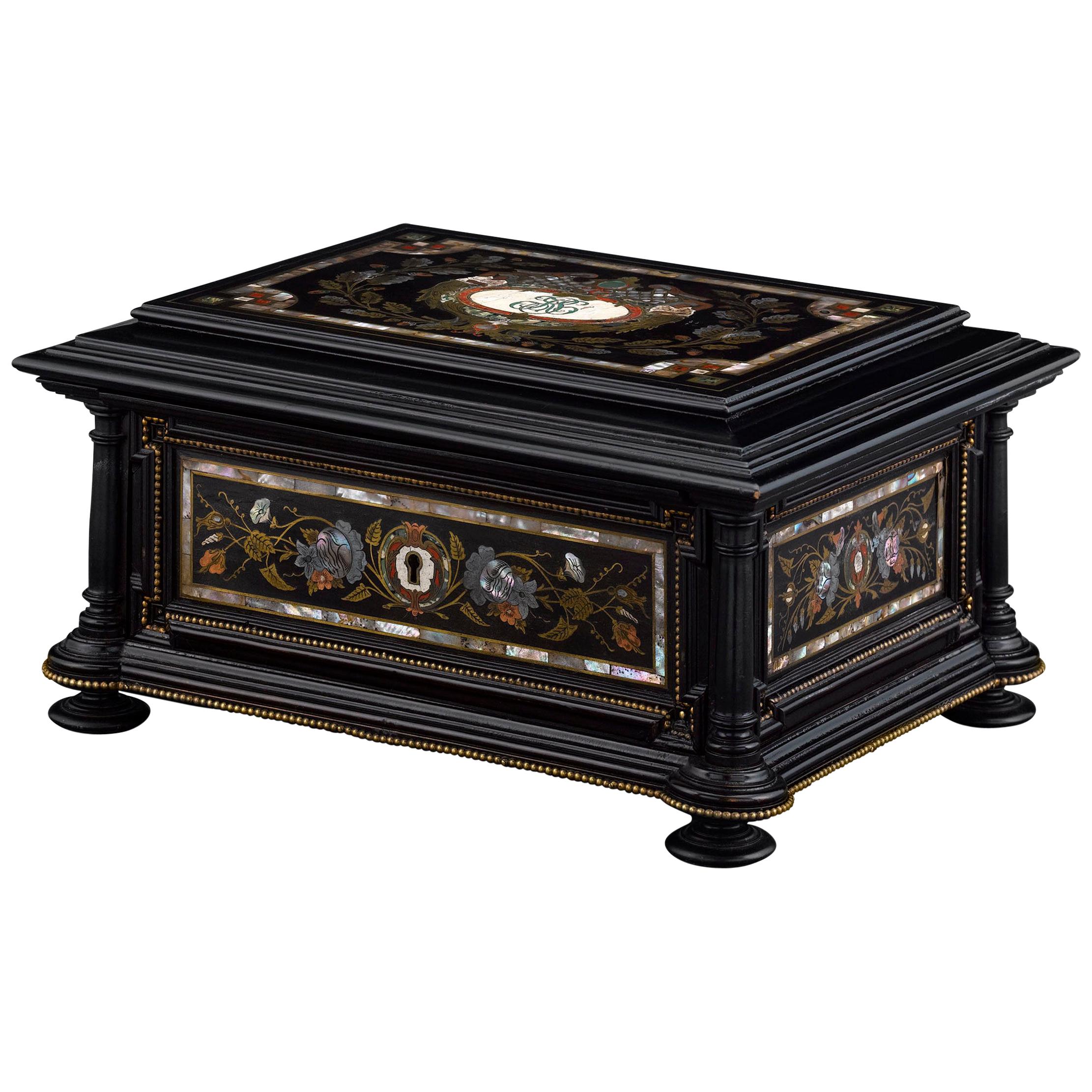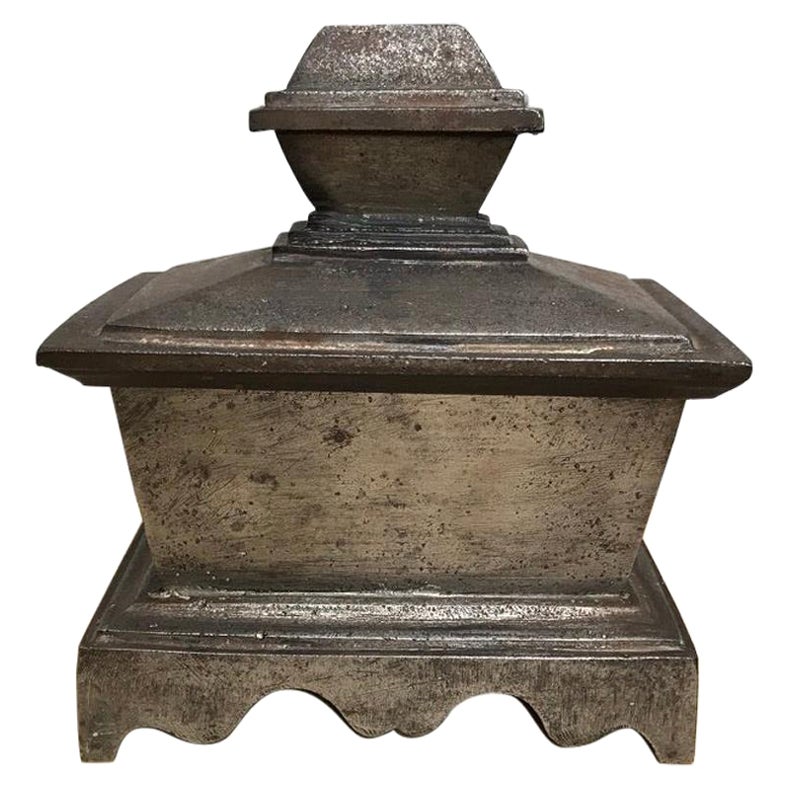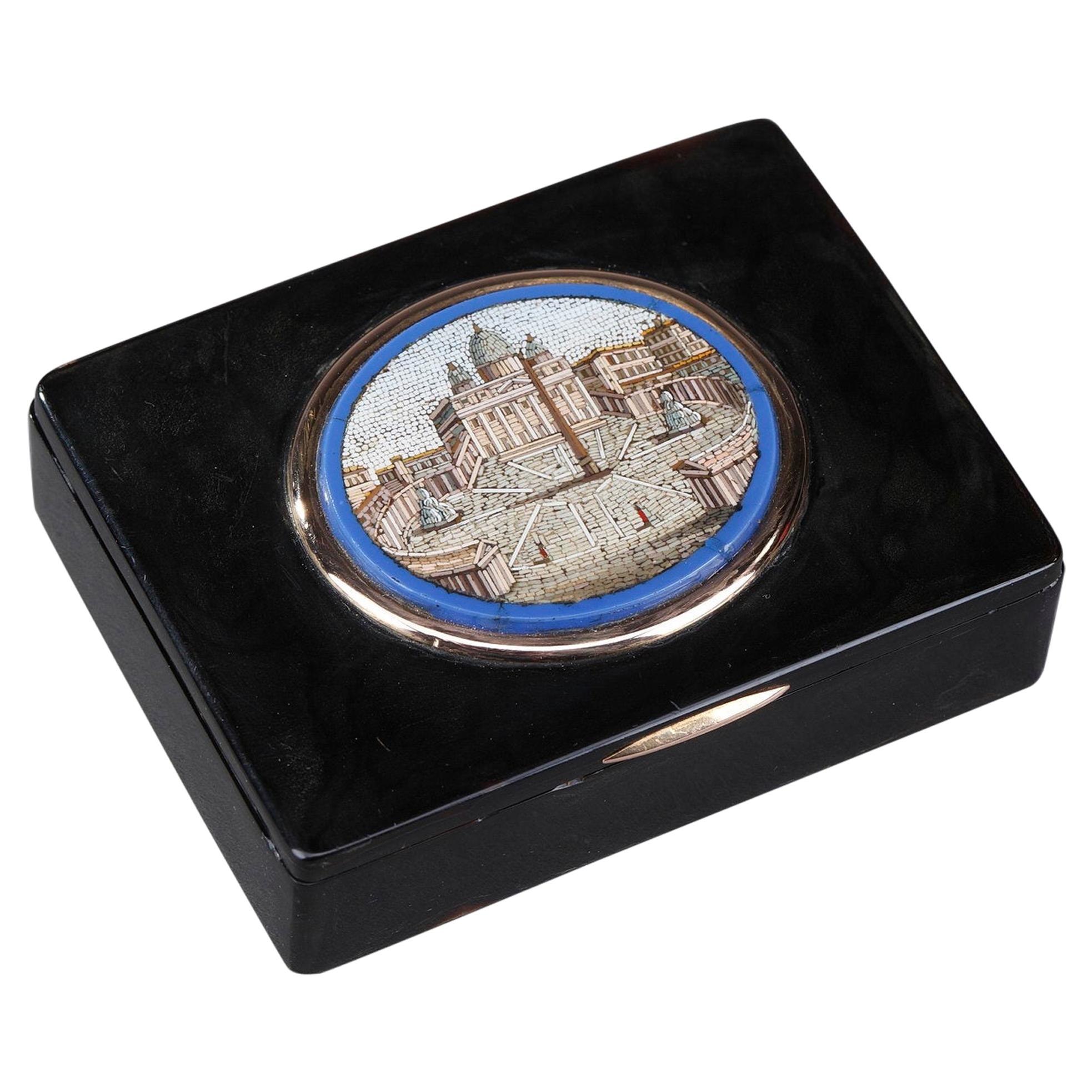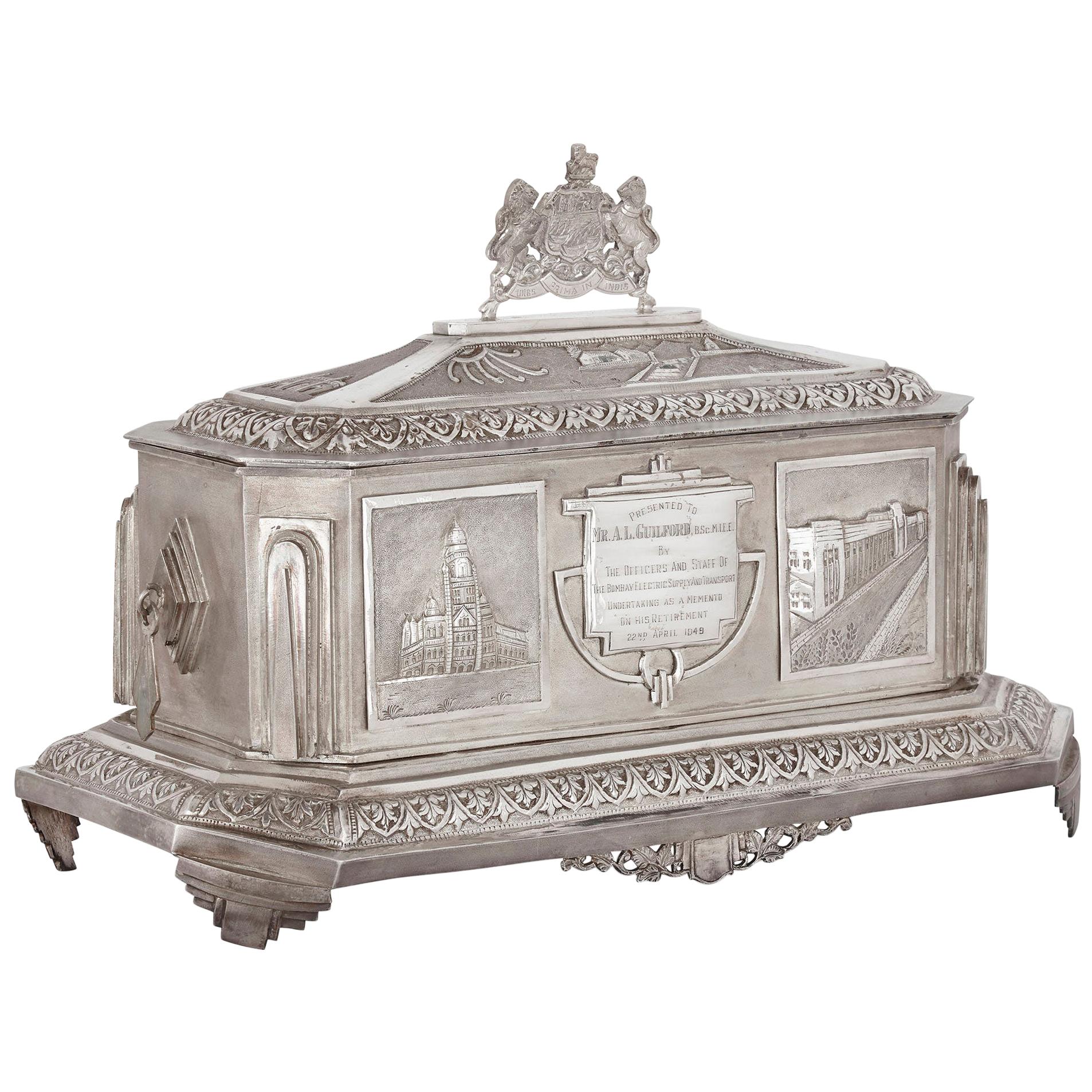Items Similar to Micromosaic and Pietre Dure Grand Tour Casket
Want more images or videos?
Request additional images or videos from the seller
1 of 6
Micromosaic and Pietre Dure Grand Tour Casket
About the Item
The time-honored decorative techniques of pietre dure and micromosaic are combined in this rare and exceptionally-crafted Grand Tour casket. Serving as a memento of this once-requisite rite of passage for young gentlemen of the upper class, this large ebonized wood casket features five resplendent micromosaic plaques on the lid, each recreating some of the most historic monuments of ancient Rome, including the Temple of Vespasian, the Pantheon and the Colosseum, with outstanding intricacy. Bursting forth with color and incredible artistry is the hardstone pietre dure relief work depicting ribbon-tied boughs of lush fruit and leaves. Highlighting this assemblage of creative skill are wonderfully chiseled gilt bronze mounts that draw the eye to the magnificent workmanship imparted upon this exquisite objet d'art.
Wealthy aristocrats making their Grand Tour through Italy were very fond of pietre dure and micromosaic works. These techniques were expensive, requiring not only precious materials but highly skilled craftsmen. Authentic hardstone pietre dure and micromosaic works such as this are very rare and were available only to the wealthiest European tourists and to wealthy Italian royals. The techniques were rarely applied to a single work simultaneously, as demonstrated by this casket, making it an incredible specimen of Italian decorative art,
circa 1850.
Measures: 8 7/8" wide x 7 5/16" deep x 5 3/4" high.
- Dimensions:Height: 5.75 in (14.61 cm)Width: 8.88 in (22.56 cm)Depth: 7.32 in (18.6 cm)
- Style:Greco Roman (In the Style Of)
- Materials and Techniques:
- Place of Origin:
- Period:
- Date of Manufacture:circa 1850
- Condition:
- Seller Location:New Orleans, LA
- Reference Number:
About the Seller
5.0
Recognized Seller
These prestigious sellers are industry leaders and represent the highest echelon for item quality and design.
Established in 1912
1stDibs seller since 2010
93 sales on 1stDibs
Typical response time: 7 hours
- ShippingRetrieving quote...Ships From: New Orleans, LA
- Return PolicyA return for this item may be initiated within 7 days of delivery.
More From This SellerView All
- Pietre Dure And Doré Bronze Box By TahanBy Jean-Pierre TahanLocated in New Orleans, LACrafted by Jean-Pierre-Alexandre Tahan, the esteemed cabinetmaker to Napoléon III, this jewelry box is a remarkable example of 19th-century European artistry. The box, shaped in doré...Category
Antique 19th Century French Empire Jewelry Boxes
MaterialsStone, Bronze
- Musical Jewelry and Sewing CasketLocated in New Orleans, LAThis charming musical jewelry and sewing box is a work of sublime artistry. Almost certainly German or Austrian in origin and crafted of deep, ebonized...Category
Early 20th Century Austrian Other Decorative Boxes
MaterialsMulti-gemstone
- Grand Ducal Pietre Dure Console TablesBy Andrea BrustolonLocated in New Orleans, LAAmong the most beautiful examples of hardstone artistry that have ever entered our collection, these important Grand Ducal pietre dure console tables are in a class all their own. Their powerful architectural elegance, impressive size and rarity make them two of the finest hardstone masterpieces ever created and quite possibly the greatest pair of pietre dure tables in existence. With their naturalistically rendered flowers and birds, these tabletop panels showcase the particularly fine quality craftsmanship of the Grand Ducal workshops in Florence during the first quarter of the 17th century. Grand Duke Ferdinando I de Medici, one of the most important personages in the annals of art history, established the Grand Ducal Workshop in 1588. The workshop specialized in the art of pietre dure developed from the ancient art of opus sectile, giving rise to the most luxurious and detailed examples of hardstone artistry ever produced. Its patrons were the Popes and Royals of Europe, and the quality of the objects produced in the workshop is without equal. Typically, because of the high level of workmanship the art form requires, pietre dure plaques were crafted in small sizes. The great majority of known examples of pietre dure are a fraction of the size of our grand tables. The combination of pietre dure and extensive use of other rare decorative hardstones such as lapis lazuli and pietra paesina or “ruin marble” meant that these tabletops were surely produced for a wealthy collector. The tables are further distinguished by their superbly carved bases by Andrea Brustolon, known as the “Michelangelo of wood.” Brustolon was a Venetian wood sculptor known for his exuberant and intricate Baroque furniture. His high Baroque style was influenced by his years studying in Rome, where he was exposed to the sculpture of Gian Lorenzo Bernini. Crafted in the early 18th century, these bases display Brusolon’s unmatched talent for both figural and foliate work, combining cupids, masks and oversized scrolling vines for a grand, ornate effect. Similar furnishings by Brustolon are held in museums worldwide, including the Victoria & Albert Museum, the National Museum of Scotland and the Metropolitan Museum of Art, while the Ca' Rezzonico Museum in Venice features an entire room dedicated to the sculptor. For approximately 150 years, these tables were part of the famed Stoneleigh Abbey collection owned by the Lord Leigh family. This renowned English country estate inspired Jane Austen to write Mansfield Park. Lord Leigh eventually sold the tables at Christie’s London in 1962, and the pair have stayed in the collection of the same Florentine family who purchased them from Christie's until we recently acquired them. Our tables are prominently pictured in the important Saul Levy book Il Mobile Veneziano del Settencento. The pietre dure plaques date circa 1625-1650. The decorative tops likely would have originally been sold with a pair of plain stone columns to display them, and Lord Leigh would have commissioned the custom bases from Brustolon circa 1714 when he added the impressive four-story fifteen-bay Baroque West Wing to Stoneleigh Abbey. A similar single Grand Ducal tabletop is in the United Kingdom’s National Trust Collection, and a smaller tabletop resides in Buckingham Palace. The flower and bird panels in our examples relate to the famous Badminton Cabinet...Category
Antique 17th Century Italian Baroque Side Tables
MaterialsWood
- Russian Malachite and Pietre Dure PlinthsLocated in New Orleans, LAThe exquisite art of pietre dure is at its absolute finest in this spectacular pair of Russian ormolu and malachite plinths. True works of art of the Restauration period, these plinths each feature a matching pietre dure mosaic crafted of the finest stones, all chosen to create a sense of depth and dimensionality in the final work. Depicting an onyx vase with tulips, roses, daffodils, magnolia and other flowers, these pietre dure panels are among the finest examples of this ancient art we have seen. The pietre dure is complemented by malachite panels of the highest quality, exhibiting exceptional depth through its extraordinary cellular structure. Malachite is one of Russia’s most precious stones, and its presence in these plinths indicates commission and ownership by an individual of considerable status. Mounted in an excellent stepped ormolu base, these plinths originally served as bases for vases or candelabra. The overall execution and appearance of these plinths is very characteristic of the taste associated with the immensely wealthy collector Nicolas Demidoff. As early as 1806, Demidoff had commissioned the Parisian goldsmith Henri August to supply a guéridon; in 1819, he ordered famed French bronzier Pierre-Philippe Thomire to supply mounts for a massive malachite vase (now in the Metropolitan Museum of Art, New York), as well as a console table with legs in the form of Nike. Other commissions included a table given as a gift to Grand Duke Leopoldo II of Florence, now in the Pitti Palace. Demidoff eventually settled in Florence in 1822 and became Russian minister to the Tuscan Court. Elevated to the rank of Count of San Donato by the Grand Duke, he built a magnificent villa at San Donato on the site of lands formerly owned by the Medici. The villa was later inherited by Anatole, his son, Prince of San Donato, and there are records which confirm transactions he had with the Opificio delle Pietre Dure. The 19th century proved to be the golden age of Russian malachite. The stone became a sign of prestige and a token of wealth, so much so that Russian papers of the time wrote: "To afford having a big piece wrought in malachite is synonymous to owning diamonds." Year after year the Russian (Romanov) treasury paid increasingly unreasonable prices to hoard the best malachite, much of which went into Romanov palaces and extravagant objets d'art. The Hermitage Museum possesses a collection of over two hundred examples of this “palatial” malachite...Category
Antique 19th Century Russian Pedestals
MaterialsMalachite, Ormolu
- Agate and Micromosaic BoxLocated in New Orleans, LAIntricate and flawless, the highly detailed micromosaic medallion on the lid of this agate box is an incredible example of this diminutive art form. The elaborate micromosaic depicts...Category
Antique 19th Century European Other Decorative Boxes
MaterialsAgate
- Swiss Gold and Enamel Musical VinaigretteLocated in New Orleans, LAA musical movement distinguishes this wonderful early 19th-century gold vinaigrette box. The vessel is covered in delicate engraving highlighted by bl...Category
Antique 19th Century Swiss Neoclassical Decorative Boxes
MaterialsMetal
You May Also Like
- Grand Tour Bronze Sarcophagus Form BoxLocated in Stamford, CTUnusual 19th century Italian Grand Tour bronze box in the form of a sarcophagus, circa 1880. Nice form, handsome desk-top accessory, great addition to any box collection. 5.5 inches...Category
Antique Late 19th Century Italian Grand Tour Decorative Boxes
MaterialsBronze
- 19th Century Italian Grand Tour Steel Lidded Sarcophagus BoxLocated in Stamford, CTRare 19th century Italian Grand Tour steel sarcophagus form box, circa 1880. Nice form, handsome desk-top accessory, great addition to any box collection. It is unusual to find this ...Category
Antique Late 19th Century Italian Grand Tour Decorative Boxes
MaterialsSteel
- 19th Century Restauration Snuff Box with MicromosaicLocated in Paris, FRSmall rectangular Restauration snuff box crafted in gold. The hinged lid is decorated with an oval micromosaic representing St. Peter's Square in Rome. Micromosaic is set in a gold s...Category
Antique Early 19th Century French Charles X Tobacco Accessories
MaterialsGold
- Anglo-Indian Art Deco Silver Presentation CasketLocated in London, GBThis Anglo-Indian silver casket is inscribed on a central panel to the front with the following: 'Presented to / Mr. A. L. Guildford, B.Sc. M.I.E....Category
Early 20th Century Indian Art Deco Decorative Boxes
MaterialsSilver
- Stunning Handcrafted Late 1800s Gothic Casket with Peacock & Gargoyle SculpturesLocated in Lisse, NLBeautiful and rare Gothic Revival treasure box with bronze handle. If you are a collector of antique boxes and/or if you are looking for an extraordinary jewelry box to grace your credenza or side table then this unique and top quality made specimen in the Gothic style could be perfect. Gothic Revival boxes are very hard to find and we have never seen one with such prodigious carvings on all sides. The unique and cat-like dragon gargoyles (with fangs) that look like they are carrying this casket, are just some of the stunningly carved and detailed sculptures that make this antique rarity even more artistic and impressive. Another great feature are the peacock sculptures. In Christianity the peacock is the symbol of purity. Christians believe that once someone has passed their soul rises and goes to heaven. This is why in earlier times Christians would spread the feathers of a peacock over the deceased since it symbolized a pure soul that was immune to corruption. The peacock also represents immortality, resurrection, and the spiritual teachings of Jesus Christ and the Christian church. Have you also noticed the top quality details on both ends of the bronze handle on top? The quality of that ornamental work is of the absolute highest standard also. There are many more incredibly beautiful, hand carved details and together they show that no expense was spared to create one of the most amazing Gothic caskets...Category
Antique Late 19th Century Italian Gothic Religious Items
MaterialsBronze, Iron
- Liberace Autographed Vintage Schoenhut Toy Grand PianoBy SchoenhutLocated in Hamilton, OntarioMade by the renowned American toy manufacturer in approximately 1920, this wooden toy baby grand piano has been autographed in two places by the legendary Liberace. The piano shows o...Category
Early 20th Century American Victorian Toys and Dolls
MaterialsBrass
